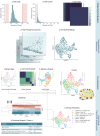Interactive single-cell data analysis using Cellar
- PMID: 35422041
- PMCID: PMC9010407
- DOI: 10.1038/s41467-022-29744-0
Interactive single-cell data analysis using Cellar
Abstract
Cell type assignment is a major challenge for all types of high throughput single cell data. In many cases such assignment requires the repeated manual use of external and complementary data sources. To improve the ability to uniformly assign cell types across large consortia, platforms and modalities, we developed Cellar, a software tool that provides interactive support to all the different steps involved in the assignment and dataset comparison process. We discuss the different methods implemented by Cellar, how these can be used with different data types, how to combine complementary data types and how to analyze and visualize spatial data. We demonstrate the advantages of Cellar by using it to annotate several HuBMAP datasets from multi-omics single-cell sequencing and spatial proteomics studies. Cellar is open-source and includes several annotated HuBMAP datasets.
© 2022. The Author(s).
Conflict of interest statement
The authors declare no competing interests.
Figures



References
Publication types
MeSH terms
Grants and funding
LinkOut - more resources
Full Text Sources

